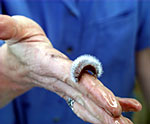|
|

 TODAY'S WEATHER Partly Cloudy 75°F (23.9°C) Latitude: 25 deg 20.5’S Longitude: 70 deg 01.5’E Wind Direction: E Wind Speed: 20 Knots Sea State 4 Swell(s) Height: 8-12 Foot Sea Temperature: 79°F (25.9°C) Barometric Pressure: 1015.6 MB Visibility: 18+ Nautical Miles  Shrimp Covered Chimneys  Chief Scientist, Cindy Van Dover, holds a bristle worm, one of the many creatures found in the samples taken at the hydrothermal vents. 
Daily Update: A bountiful haul Put scientists in sight of marine organisms and rocks they have waited 36 hours to examine and what do you get? “Madness,” said biology student Jessie Philley, standing back from the biologists and geologists flocking around the animal and rock sampling containers brought to the ship this morning. Madness, perhaps. But also magic. Since we located the black smoker chimneys three days ago, we have peered at these creatures only through a remote video camera lens. Today we were able to touch, see and smell the rocks and animals of the Indian Ocean vents up close. And smell them we did. Rotten egg odor filled our
noses when biologist Tim Shank poured a container full of fresh
vent shrimp into a bucket, then hauled them inside to begin sorting
and extracting tissue from their abdomens for his genetics research.
We slurped the white crustaceans from the surfaces of vent chimneys
hours earlier, just before triggering the elevator’s rise to the sea surface. After breakfast we gathered on deck to watch three of the ship’s crew members zip out in the motorized work boat to greet the still-rising elevator. For twenty minutes we squinted at the blue-gray chop for a sign of our elevator. Then Seaman Ed Graham shouted from his crane perch: “Hey, it’s over there!” A quarter mile off the starboard side, the elevator’s yellow plastic floats bobbed in the six-foot seas. The work boat crew slowly worked their way to its side, attached a line and dragged it to Knorr. Though excited, the scientists took care in removing their samples from the elevator’s containers. Accurate research means keeping track of each crab, rock and any other specimen collected, no matter how tiny. “That way, we don’t mix up the data,” said biologist Tim Shank. Jason followed the elevator’s arrival on Knorr an hour later. Other than a broken temperature probe, Jason is working well. The DSOG team will fix the probe and make adjustments to the elevator before we return both to the seafloor tonight for further collection and exploration. “Testing equipment on the seafloor is trial and error,” said geologist Dan Fornari. “We are on a steep learning curve but the DSOG folks have been doing this for over a decade and are some of the best in the business.”
|
||||||||||||||||||||||||||||||||||||||||||||||||||||||||||||||||||||||||||||||||||||||||||||||||||||||||||||||||
Mailing List | Feedback | Glossary | For Teachers | About Us | Contact
© 2010 Dive and Discover™. Dive and Discover™ is a registered trademark of
Woods
Hole Oceanographic Institution